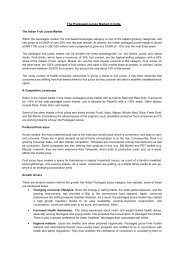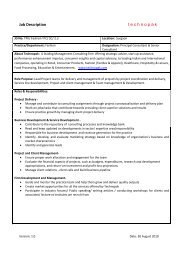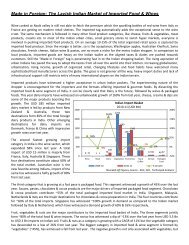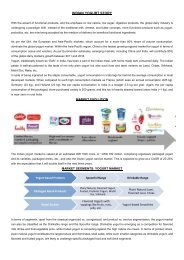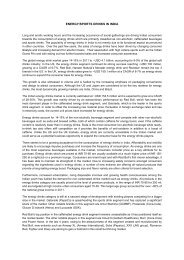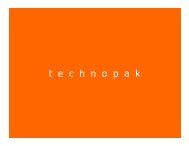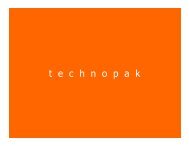a quarterly report by - Technopak
a quarterly report by - Technopak
a quarterly report by - Technopak
Create successful ePaper yourself
Turn your PDF publications into a flip-book with our unique Google optimized e-Paper software.
perspective<br />
a quar terly repor t <strong>by</strong><br />
Volume 02 / 2009<br />
| Volume 02<br />
Cost per Seat Estimations in the Private<br />
Higher Education Segment<br />
Cost per seat estimations in higher education would vary depending on the scale of the project and the<br />
cost of land. Enclosed are few parameters on which we have calculated that a medical seat would cost<br />
~ US$ 104,166 and a non-medical seat would cost ~US$ 14,580 to be created <strong>by</strong> a private player. The<br />
assumptions backing these estimates are outlined below. In these calculations we have assumed that<br />
100% students would be residing in the hostel and the cost per acre of land is ~ US$ 520,800.<br />
Exhibit 6<br />
Thumb Rules for Investments in Private<br />
Education<br />
It has become evident in the last decade or so that government alone cannot bear the cost of the education<br />
sector and this sector particularly lacks proper investments, which is a constraint in coping with growing<br />
market demand and global competition. To bridge the gap, the private sector has stepped in. Education<br />
as an investment sector is often viewed as safe <strong>by</strong> the investors. With the attractive rates of return and<br />
the growth potential, it is one of the hot favorite sectors for the private players and private equity funds in<br />
India.<br />
A few thumb rules for entrepreneurs and companies wanting to invest in education are listed below.<br />
‘Market’ Assessment<br />
A pragmatic assessment of the “catchment” in each segment of education is important, from the standpoint<br />
of achieving required student enrollment, before planning an investment. The catchment (travel time from<br />
institute) for a pre-school would be 30 minutes, for a K-12 day school would be 60 minutes, and for a<br />
residential school this would be 5 hours. Demand for a vocational training institute originates from within<br />
its city premises, with few students travelling across cities for enrollment. A university or a higher education<br />
institute would attract students from all parts of India (as well as South Asia, the Middle East and Africa), the<br />
catchment being dictated <strong>by</strong> the quality of education on offer and the reputation of the institute.<br />
Key Financials<br />
A regular day K-12 school, built over 2 acres of land with a capacity of 2,100 students, would require an<br />
investment of ~US$ 3.1 Mn, and so would an MBA Institute with a capacity of 240 students enrolled in a 2<br />
year course spread over 1.5 acres of land. An engineering college with a capacity of 1,600 students spread<br />
over 10 acres of land would require an investment of ~US$ 21 Mn. The project cost for setting up a private<br />
71 | Forecasting the Financial Potential in Education<br />
Cost Per Seat Estimations in Different Streams of Higher Education<br />
Engineering MBA MCA Architecture Medical<br />
Max No of Students Enrolled 1680 240 360 200 500<br />
Course Duration 4 2 3 5 5<br />
Capex (US$ Mn) 16-26 3-4 4-5 3-4 46-52<br />
Cost per Seat (US$) 12,500 14,580 12,500 18,750 104,166<br />
Cost Per Seat Excluding Land (US$) 9,380 11,460 9,790 13,542 66,666<br />
Area of Land 10 acres 1.4 acres 2acres 1.4 acres 25 acres<br />
Hostel Development Cost (US$) 4.6 Mn 750,000 1.1Mn 625,000 1.5 Mn<br />
Source: <strong>Technopak</strong> analysis



